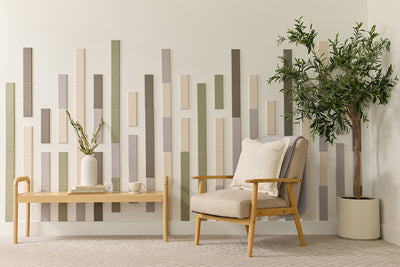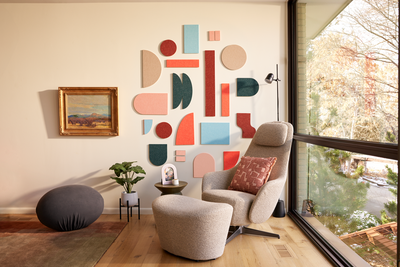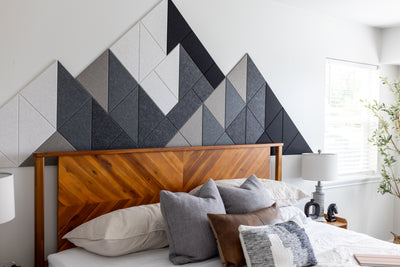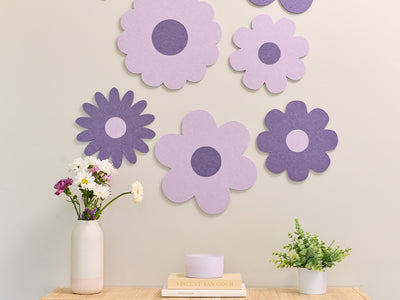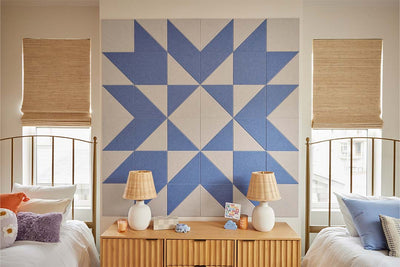Solving Acoustic Problems in 5 Different Types of Spaces

We all love peace and quiet, right? Then why is it so hard to come by in our homes, offices, or most other interior spaces? The quality of sound and acoustics in your space may often be overlooked, but achieving good acoustics is important for many reasons. The sounds in your space can impact your productivity, mood, creativity, and even your mental and physical health. Just think about the last time you tried to focus on a task while you were consumed by the sounds of traffic, noisy neighbors, or a talkative coworker.
In this blog, we’re taking a closer look at acoustics and how you can work to solve acoustic problems in various different spaces for your home or office. Many people are shocked by how quick and easy it can be to transform the quality of acoustics and sound in your spaces to help you focus, relax, and enjoy your time indoors.
Felt Right is proud to be an industry leader in designing innovative felt tiles and felt boards for your home, office, or any interior space. We believe in products that are both advanced and environmentally friendly, which is why we utilize sustainable production processes. Our easy-to-install felt panels can help you quickly transform the acoustics in your home or office. Now, doesn’t that sound great?

What Do We Mean By Acoustics?
We’ve all heard this word before, but have you stopped to think what it actually means? Acoustics refers to the science and study of sound. This word also helps us to describe the quality of sound as we experience them in different types of spaces. When we say, for example, that a room has “good acoustics,” we mean that it’s a suitable place to have conversations, listen to music or watch television, or focus and get work done.
Luckily, you don’t need to be an acoustics expert to acoustically treat your home or office. By using sound dampening products, such as acoustic tiles, on your walls, you can easily create quality acoustics for any interior space. What makes these acoustic wall tiles so effective at reducing unwanted noise is the innovative PET felt material. This material naturally absorbs a percentage of incoming sound waves, which works to improve the acoustics in your space.

Solving Acoustic Problems in Your Office
No matter if you’re working in a traditional office or designing your own home office, it’s important to work in a place with good acoustics where you can be productive and focus. Of course, this is often easier said than done, which is why achieving quality acoustics in your workspace is especially important.
In an office, competing intermittent speech, such as conversations, greatly impacts the intelligibility of conversations. Open layouts also make it more difficult to effectively control sound in these spaces.
How can you solve acoustic problems in your office?
- Put distance between conversations and sources of competing intermittent speech.
- Face workspaces away from each other to use the directionality of higher frequency sounds (like human voices) to your advantage.
- Move noise surfaces, such as printers or copiers, away from listeners.
- Install felt wall tiles between coworkers and between a person and a noise source.
- Seal off quiet work areas from adjacent spaces creating excess noise.
- Replace hollow-core wood doors with heavy solid-core doors.
- Add absorptive materials and furniture in spaces to reduce the reverberation time of sound waves in the space.

Solving Acoustic Problems in Your Living Space
In many ways, the living room is the heart of your home. This is the space where you relax and spend time with your family, friends, and enjoy your favorite entertainment. Whether it’s watching television, listening to music, or having a conversation, the acoustics in your living space certainly matter.
Hardwood floors will create a significant amount of diffusion, which can be addressed by adding pieces of soft furniture. Additionally, the material of your furniture matters. Thick leather furniture will absorb low to midrange frequencies, but may diffuse higher frequencies. Microsuede, cloth, and some softer leathers will only provide absorption across the frequency spectrum.
How do you solve acoustic problems in your living space?
- Place absorption at reflection points between viewers and the television or speaker systems for better acoustics and the ability to listen at lower volume levels.
- With surround sound systems, treat the loudest speakers first with reflection points on the side walls.
- Treat your hard floor surfaces with a rug or other type of soft covering.

Solving Acoustic Problems in Your Podcast or Recording Studio
Nowadays, it seems like almost everyone has their own podcast. If you’re looking to produce your own podcast or even set up your own in-home recording studio, then you already know the importance of good acoustics. Controlling the noise in your podcast studio or recording studio is essential to create a high-quality audio experience.
Untreated first reflection points in your podcast studio will cause destructive interference between the speaker and the audio capture device (microphone). Make sure you know what type of microphone you’re using to assess the “pickup patterns” to help you identify which first reflection points need to be treated. The difference between cardioid and omnidirectional microphones will matter when it comes to treating your acoustic space.
How can you solve acoustic problems in these spaces?
- Use microphone placement to your advantage:
- Cardioid microphones should be pointed into the room rather than facing a wall. Use felt wall tiles to treat the nearest reflection points within the microphone’s pickup pattern area.
- Omnidirectional microphones should be placed toward the center of the room and far from reflective surfaces—if possible. Treat the nearest reflection points regardless of direction. Turn down the microphone’s gain setting and get your subject closer to the microphone.
- Install felt wall tiles between the speaker and the microphone.
- For surfaces that cannot be acoustically treated, such as computer monitors, you can place a mirror on them and angle it so you cannot see the microphone’s reflection when you’re in the speaking position.
- For your desk, place the microphone off the edge of the desktop with the front facing outward for a cardioid microphone. For the omnidirectional microphone, place the microphone close to your mouth with the preamplifier gain turned down so you pick up less desk reflection energy.
- To acoustically treat your desk, use a thick blanket to create an absorptive nest for the microphone to rest on.
- Reduce background noise by sealing off recording areas from noisy, adjacent spaces.
- Reduce unwanted vibrations through the microphone body by using a shock mount to complement your stand.

Solving Acoustic Problems in Your Conference Room
Clear communication is essential for any conference room. After all, isn’t that the purpose of these spaces to begin with? No matter the size, shape, or location of your conference room, there are certain aspects to consider to improve the acoustics and help you get work done. Most conference rooms are filled with hard surfaces and materials, such as glass, whiteboards, and desks. Using video or phone conferencing can create multiple points of communication and reception, which can make the acoustics challenge even trickier.
How can you solve acoustic problems in your conference room?
- Generally, the more absorption the better. Distribute sound dampening felt tiles around the room as they fit with your comfort and taste.
- Placement options: center of the conference table, ceiling, or empty walls. As an added bonus, you can make these surfaces more useful by pinning ideas, charts, and inspiration to your conference room walls with Felt Right tiles.

Solving Acoustic Problems for Video or Phone Conversations
In the age of working from home, video and phone conversations have never been so frequent—or so important. As professionals develop ways to effectively work together from miles (or countries) away, video conferences and phone calls are essential to ensure that communication is maintained and projects get accomplished. Similar to a podcast or recording studio, your communication needs will often take place in front of a desk or a computer monitor—both of which are highly reflective surfaces.
How can you solve acoustic problems for video and phone conversations?
- Try to angle your desk or monitor slightly to force reflections past the microphone.
- If you’re stationary and using a webcam microphone, treat all around the webcam for omnidirectional microphones and the side walls and ceiling for those using cardioid microphones.
- In small spaces, treat the surface behind the head of the speaker. Also, treat first reflection points with sound dampening tiles to have a greater acoustic impact.

Conclusion – Solving Acoustic Problems in 5 Different Types of Spaces
It’s time to take back control of the acoustics in your space. Whether it’s your home, office, conference room, podcast studio, or living room, it’s important to achieve quality acoustics for your interior spaces. Good acoustics can help you focus, boost productivity, and even improve your mood. While there are many ways to improve the acoustics in your space, using felt wall tiles is one of the quickest, most convenient, and cost-effective options. By simply hanging up these colorful and aesthetically-pleasing felt tiles in your space, this innovative sound dampening material can absorb unwanted noise and help you achieve quality acoustics.
If you’re looking to control the acoustics in your space, Felt Right felt tiles are for you. Our felt wall tiles come in a wide variety of shapes, patterns, and colors so that you can design a felt board that fits your tastes and style. Created with sound dampening felt material, our felt tiles absorb sound waves and improve the overall quality of sound in your rooms.
Head over to the My Design Studio to start creating your own felt tile design today.

